Analysis of strategy and skills
Analysis of strategy and skills in 11 countries and regions outside Japan and China
The strategies and skills of China, the only winners at these Championships, and Japan, the big losers, are described in detail on pages 14 to 16, but how are the strategies of the other countries and regions developing? We have collected the results of the strategies of each country and region from the early part of the competition and analyzed their technical strengths. Here we introduce those countries and regions in order of winning percentages.
Indonesia
![]()
Excellent strategy and technical strength but lost to the eventual runners-up
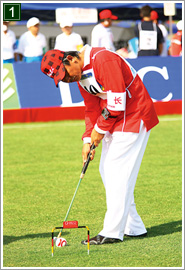
Two teams took part and their overall results were won 3, lost 3. They developed basic strategies. Partisan Gateball Bali won 2 and lost 1, with some of the same players who helped the team reach the quarter-finals of the 2nd Asian Championships. Their single loss was unfortunately against eventual runners-up YUNNAN LIMING.
- Inyoman Seniartha Prawita (55) of Partisan Gateball Bali Good ball control resulting from lots of training, he uses both a stroke swing and a between-the-legs swing.
Paraguay
![]()
Achieved good scores with basic strategies and steady skills
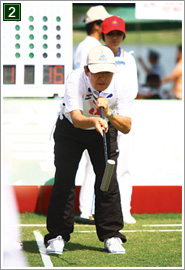
Two teams took part and their overall results were won 3, lost 3. They had a firm grasp of basic strategies and developed a 2nd line edge strategy too. Both teams were composed of ethnic Japanese players but their A team earned a respectable second place finish on their court with two wins and one defeat. The team that beat them was HSIN-CHU CITY GATEBALL, who must have been strong because they were the only Taiwanese team to progress to the final tournament stage.
- Masatake Kataoka (69) of Paraguay A Steady technique with a between-the-legs swing and a stroke swing
South Korea
![]()
Lost disappointingly without showing their true ability
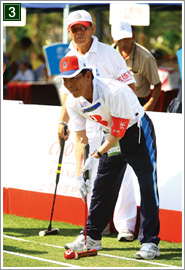
Nine teams took part and achieved overall results of 12 wins and 15 losses. With a rich variation in strategy, four of their teams scored two wins and one loss in the qualifying leagues so only just failed to progress to the final tournament stage.
- Maengsoo Il (70) of Korea Union Often used a very open between-the-legs swing. His big backswing and follow through give him extra distance
Hong Kong, China
![]()
Rich in competitive experience, good strategy and skills
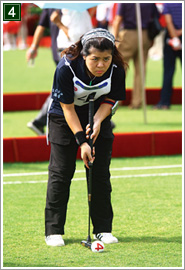
Five teams took part and achieved overall results of seven wins and nine losses. As strategies, they often lose when they take the court first. Although they play many exchange competitions with other countries and their players have good strategy and between-the-legs swing technique, their weak point is competitiveness. HONG KONG, CHINA TEAM NO.1 got three wins and no defeats in their qualifying league to get to the final tournament stage but then lost in Round 1.
- So Man Yin (29) of HONG KONG, CHINA TEAM NO.2 Most players utilize a between-the-legs swing with good leg stance
Chinese Taipei
![]()
Never showed their ability and looked off form whether taking the field first or second
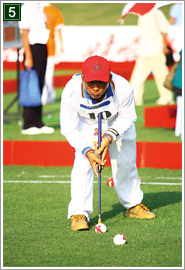
Eleven teams took part and achieved overall results of 13 wins and 21 losses. They demonstrated a rich variation in strategy and matched their opponents' technique, but were unable to realize their full potential. The exception was HSIN-CHU CITY GATEBALL who won their qualifying league with two wins and one loss, but in Round 1 of the final tournament stage they were beaten by FUJIAN on a tiebreak after tying 13-13.
- Yu Jen-Ping (59) of MAO-LI Played with an unorthodox sideways between-the-legs swing and a stroke swing, but could not maintain steady technique
Macao China
![]()
Have developed basic strategies but their technique lags behind

Five teams took part and achieved overall results of five wins and ten losses. They demonstrated basic strategy, but poor ball control with their between-the-legs swing meant their ball positioning was off. MACAU GATEBALL TEAM 2 scored two wins and one loss in their qualifying group but a loss to a Chinese team frustrated their progress to the final tournament stage.
- Wu Fong Peng (56) of MACAU GATEBALL TEAM 4 Utilized Korean and other style between-the-legs swings but their sense of distance was inconsistent
Russia
![]()
Understand basic strategy but lack competition experience
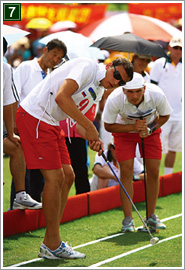
One team took part and achieved one win against two losses. They understood basic strategies such as adopting a 1st corner strategy against the 2nd gate near-left strategy of HONG KONG, CHINA TEAM NO.4, but as the game developed they were unable to predict what tactics their opponents would use next. This is probably due to their lack of experience in competitive events.
- Alexey Bykov (25) of Russia Sakhalin Used stroke swing as well as between-the-legs swing with extended back, but a lack of control prevented them from getting proper connection with the ball
Brazil
![]()
Brazil 8 made the last 16 but their other teams lost
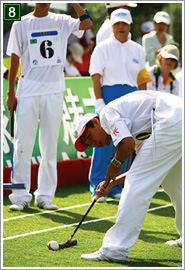
Fifteen teams took part and achieved overall results of 15 wins and 32 losses. They understand and use the basic strategies but lack the skill to turn this into victory. However, Brazil 8 battled bravely to the last 16, winning their qualifying league with two wins and a loss and then defeating Shizuoka in Round 1 of the tournament stage before finally losing to SHANXI LINFEN (China) in Round 2.
- Marco Tulio Toguchi (23) of Brazil 6 Demonstrated a range of swings including a low-stance stroke swing, between-the-legs swing, and side swing but the skill varied from player to player
USA
![]()
Skills and strategies did not work, and they sometimes failed to pass through 1st gate
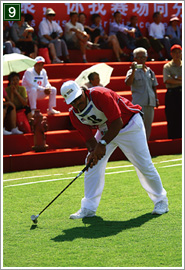
Four teams took part and achieved overall results of three wins and nine losses. They have developed basic strategies but their use of a 3rd gate area strategy in three matches was probably due to their failure to pass through the 1st gate. This kind of poor ball positioning resulted in a very shaky performance. Even the Deigo USA team, which contained experienced players from Deigo B who finished third in the 7th Championships, finished with one win and two losses in their qualifying league.
- Chandler Jeffery (53) of the Kauai USA team Utilized stroke swing and between-the-legs swing but couldn't achieve stable ball control
Australia
![]()
Although they developed basic strategies, they lacked technique
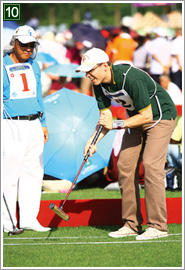
Five teams took part and scored overall results of three wins and 12 losses. They certainly used basic strategies in the early stage of the Championships, a 2nd gate near-right strategy when they hit first and a 3rd gate area strategy when they hit second, but they always handed the initiative to their opponents because they were unable to read their next moves.
- Alex Park (28) of Canberra, Australia A straight-backed between-the-legs swing meant loose ball control and poor ball positioning.
Philippines
![]()
Understood basic strategies but lacked any ball control
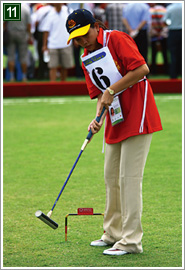
Two teams took part and scored overall results of one win and five losses. They had a grasp of the basic strategies, but this was their first appearance in the Championships and they lacked competition experience. They will take encouragement in future from their only victory, against the Brazil 4 team.
- Donna Me F. Ferriol (25) of Philippines B Although they employed the Japanese pendulum swing, their ball control was too loose so they got stuck in front of the 2nd gate where they could be attacked by their opponents.

